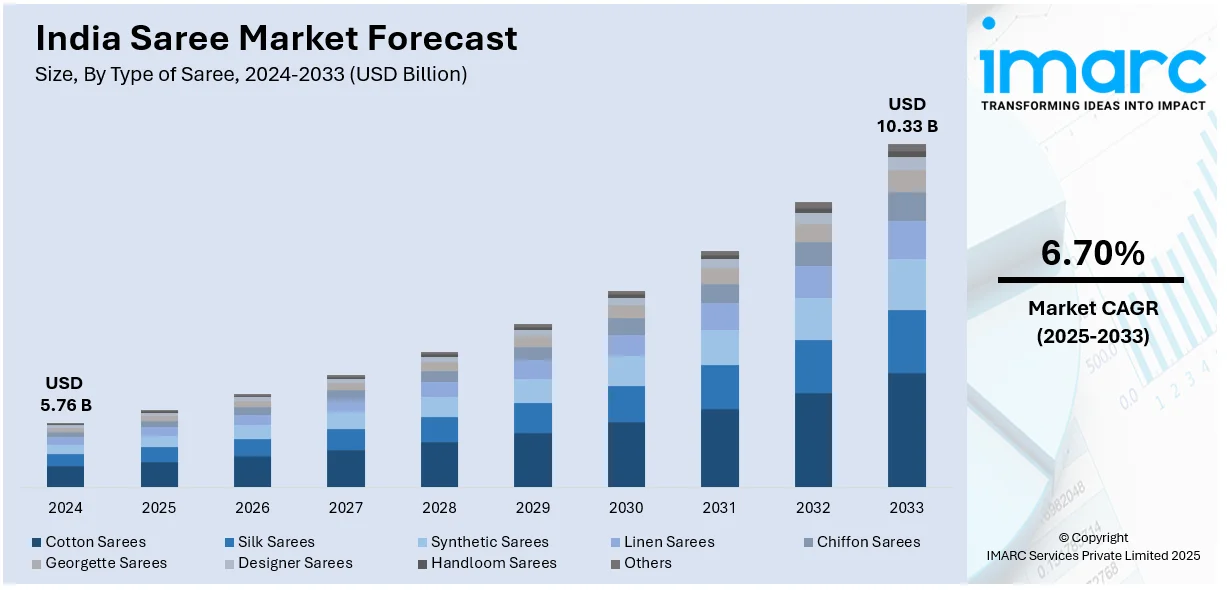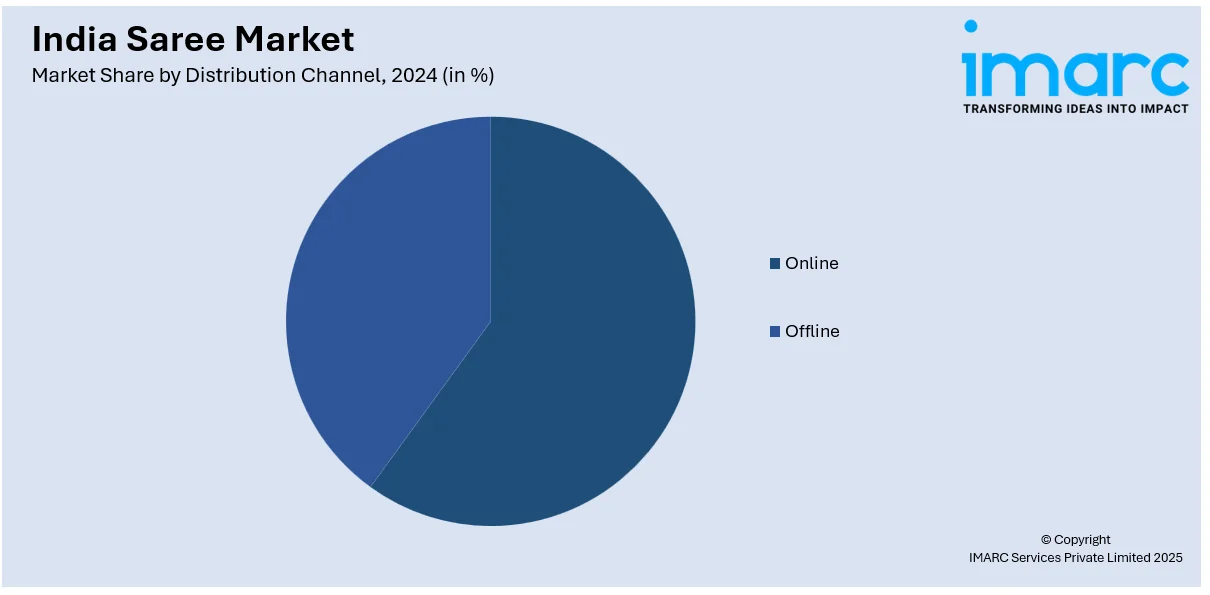
India Saree Market Size, Share, Trends and Forecast by Type of Saree, Price Range, Distribution Channel, and Region, 2025-2033
India Saree Market Overview:
The India saree market size reached USD 5.76 Billion in 2024. Looking forward, IMARC Group expects the market to reach USD 10.33 Billion by 2033, exhibiting a growth rate (CAGR) of 6.70% during 2025-2033. The market is driven by increasing consumer preference for sustainable handloom sarees, supported by government initiatives such as GI tags and the Handloom Mark, which enhance authenticity and weaver livelihoods. The rapid adoption of e-commerce, fueled by AI-driven customization, virtual try-ons, and social commerce, is broadening accessibility and convenience for buyers. Additionally, celebrity endorsements and eco-conscious branding are attracting younger demographics, further augmenting the India saree market share.
|
Report Attribute
|
Key Statistics
|
|---|---|
|
Base Year
|
2024
|
|
Forecast Years
|
2025-2033
|
|
Historical Years
|
2019-2024
|
| Market Size in 2024 | USD 5.76 Billion |
| Market Forecast in 2033 | USD 10.33 Billion |
| Market Growth Rate 2025-2033 | 6.70% |
India Saree Market Trends:
Rising Demand for Sustainable and Handwoven Sarees
The market is witnessing a significant shift toward sustainable and handwoven sarees, driven by increasing consumer awareness about eco-friendly fashion. Traditional weaves, including Banarasi, Chanderi, and Kanjeevaram are gaining popularity as buyers prioritize ethical production and artisanal craftsmanship. Government initiatives such as the "Handloom Mark" and "Geographical Indication (GI) tags" have further enhanced consumer confidence in authentic handloom products. India's handloom sector, employing more than 3.5 million artisans, 72% of whom are female, is sustained by 2.8 million looms and is a world leader in exports of handwoven sarees and home furnishings. During the fiscal year 2023, handloom exports totaled USD 10.94 Billion, with saree manufacturing being mainly centered around Varanasi and Kannur, with the United States accounting for 29.4% of overall handloom exports. Government initiatives such as the NHDP and RMSS are supporting the industry, such as INR 30 crore for mega clusters and 15% yarn subsidies to enhance competitiveness in the saree market. Additionally, younger generations are embracing sustainable sarees as a way to support local weavers and reduce fast fashion’s environmental impact. Brands and designers are responding by promoting organic dyes, biodegradable packaging, and fair-trade practices. Social media influencers and celebrities endorsing handloom sarees are also significantly supporting the India saree market growth. As a result, the market for sustainable sarees is expanding, with both domestic and international buyers showing keen interest in ethically made, heritage textiles.

To get more information on this market, Request Sample
Growth of Online Saree Retail and Customization
The market is experiencing rapid digital transformation, with online platforms becoming a preferred shopping destination for consumers. India's fast-developing e-commerce industry, poised to reach a value of USD 345 Billion by 2030 and USD 550 Billion by 2035, is opening new international opportunities for traditional saree sellers through digital platforms. With 944.7 million internet users and over 150 million online buyers, platforms such as Flipkart, Amazon, and ONDC are enabling entry by handloom and saree weavers to domestic and international markets. Government policies, such as 100% FDI, the growth of ONDC, and B2B e-commerce reform, are driving the digitalization in India's vibrant saree industry. E-commerce giants and dedicated saree marketplaces such are offering a vast range of regional weaves, making traditional sarees accessible nationwide. Virtual try-on features, AI-based recommendations, and detailed product descriptions are enhancing the online shopping experience. Another emerging trend is the demand for customized sarees, where buyers can personalize fabrics, colors, and embroidery to suit their preferences. Social commerce via Instagram and Facebook is also driving sales, with live demonstrations and influencer collaborations improving engagement. The convenience of doorstep delivery, easy return policies, and competitive pricing are further accelerating online saree purchases. This shift toward digital retail is expected to continue growing, especially among urban millennials and NRIs seeking authentic Indian sarees with hassle-free buying options.
India Saree Market Segmentation:
IMARC Group provides an analysis of the key trends in each segment of the market, along with forecasts at the country and regional levels for 2025-2033. Our report has categorized the market based on type of saree, price range, and distribution channel.
Type of Saree Insights:
- Cotton Sarees
- Silk Sarees
- Synthetic Sarees
- Linen Sarees
- Chiffon Sarees
- Georgette Sarees
- Designer Sarees
- Handloom Sarees
- Others
The report has provided a detailed breakup and analysis of the market based on the type of saree. This includes cotton sarees, silk sarees, synthetic sarees, linen sarees, chiffon sarees, georgette sarees, designer sarees, handloom sarees, and others.
Price Range Insights:
- Economy Sarees
- Mid-Range Sarees
- Premium/Luxury Sarees
A detailed breakup and analysis of the market based on the price range have also been provided in the report. This includes economy sarees, mid-range sarees, and premium/luxury sarees.
Distribution Channel Insights:

- Online
- Offline
The report has provided a detailed breakup and analysis of the market based on the distribution channel. This includes online and offline.
Regional Insights:
- North India
- South India
- East India
- West India
The report has also provided a comprehensive analysis of all the major regional markets, which include North India, South India, East India, and West India.
Competitive Landscape:
The market research report has also provided a comprehensive analysis of the competitive landscape. Competitive analysis such as market structure, key player positioning, top winning strategies, competitive dashboard, and company evaluation quadrant has been covered in the report. Also, detailed profiles of all major companies have been provided.
India Saree Market News:
- February 11, 2025: Indian designer Ridhi Mehra launched her saree capsule collection named 'Ever After' with corset belts and jackets that combine traditional aspects with new world trends. The collection, crafted from jacquard, tissue, and georgette fabrics with zari, cotton dori, and Marodi embroidery, presents shades from ivory to fuchsia. Targeted at contemporary saree shoppers, this line is available on Mehra's direct-to-consumer e-commerce platform in addition to her brick-and-mortar store in New Delhi, which also ships internationally.
- January 25, 2025: Taneira, a TATA brand, launched its first campaign promoting India's handwoven sarees with Silk Mark-certified collections, with celebrity faces Usha Uthup and Mrunal Thakur. The campaign focuses on authenticity, the craft of artisans, and the heritage of weaving, positioning Taneira as a trusted brand for modern saree buyers. The campaign is in consonance with the growing premium saree market in India, helping weavers along while making tradition fashionable and accessible.
India Saree Market Report Coverage:
| Report Features | Details |
|---|---|
| Base Year of the Analysis | 2024 |
| Historical Period | 2019-2024 |
| Forecast Period | 2025-2033 |
| Units | Billion USD |
| Scope of the Report |
Exploration of Historical Trends and Market Outlook, Industry Catalysts and Challenges, Segment-Wise Historical and Future Market Assessment:
|
| Type of Sarees Covered | Cotton Sarees, Silk Sarees, Synthetic Sarees, Linen Sarees, Chiffon Sarees, Georgette Sarees, Designer Sarees, Handloom Sarees, Others |
| Price Ranges Covered | Economy Sarees, Mid-Range Sarees, Premium/Luxury Sarees |
| Distribution Channels Covered | Online, Offline |
| Regions Covered | North India, South India, East India, West India |
| Customization Scope | 10% Free Customization |
| Post-Sale Analyst Support | 10-12 Weeks |
| Delivery Format | PDF and Excel through Email (We can also provide the editable version of the report in PPT/Word format on special request) |
Key Benefits for Stakeholders:
- IMARC’s industry report offers a comprehensive quantitative analysis of various market segments, historical and current market trends, market forecasts, and dynamics of the India saree market from 2019-2033.
- The research report provides the latest information on the market drivers, challenges, and opportunities in the India saree market.
- Porter's five forces analysis assist stakeholders in assessing the impact of new entrants, competitive rivalry, supplier power, buyer power, and the threat of substitution. It helps stakeholders to analyze the level of competition within the India saree industry and its attractiveness.
- Competitive landscape allows stakeholders to understand their competitive environment and provides an insight into the current positions of key players in the market.
Key Questions Answered in This Report
The saree market in India was valued at USD 5.76 Billion in 2024.
The India saree market is projected to exhibit a CAGR of 6.70% during 2025-2033, reaching a value of USD 10.33 Billion by 2033.
The cultural significance, growing demand for traditional attire, increasing disposable income, evolving fashion trends, and the rising popularity of online shopping platforms are impelling the saree market growth in India. Additionally, a desire for customization and regional preferences play a critical role in the market expansion and sustained popularity.
Need more help?
- Speak to our experienced analysts for insights on the current market scenarios.
- Include additional segments and countries to customize the report as per your requirement.
- Gain an unparalleled competitive advantage in your domain by understanding how to utilize the report and positively impacting your operations and revenue.
- For further assistance, please connect with our analysts.
 Request Customization
Request Customization
 Speak to an Analyst
Speak to an Analyst
 Request Brochure
Request Brochure
 Inquire Before Buying
Inquire Before Buying




.webp)




.webp)












